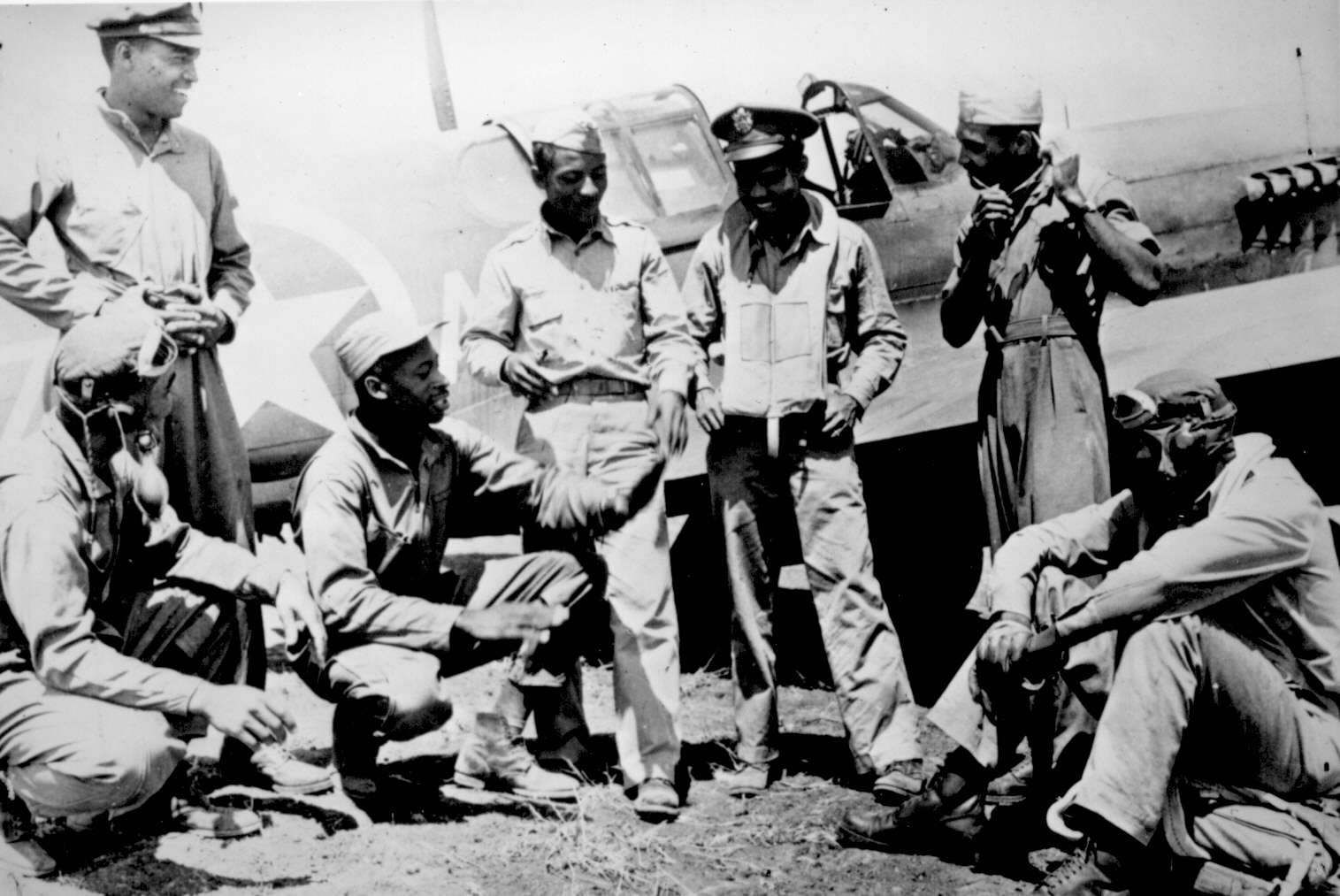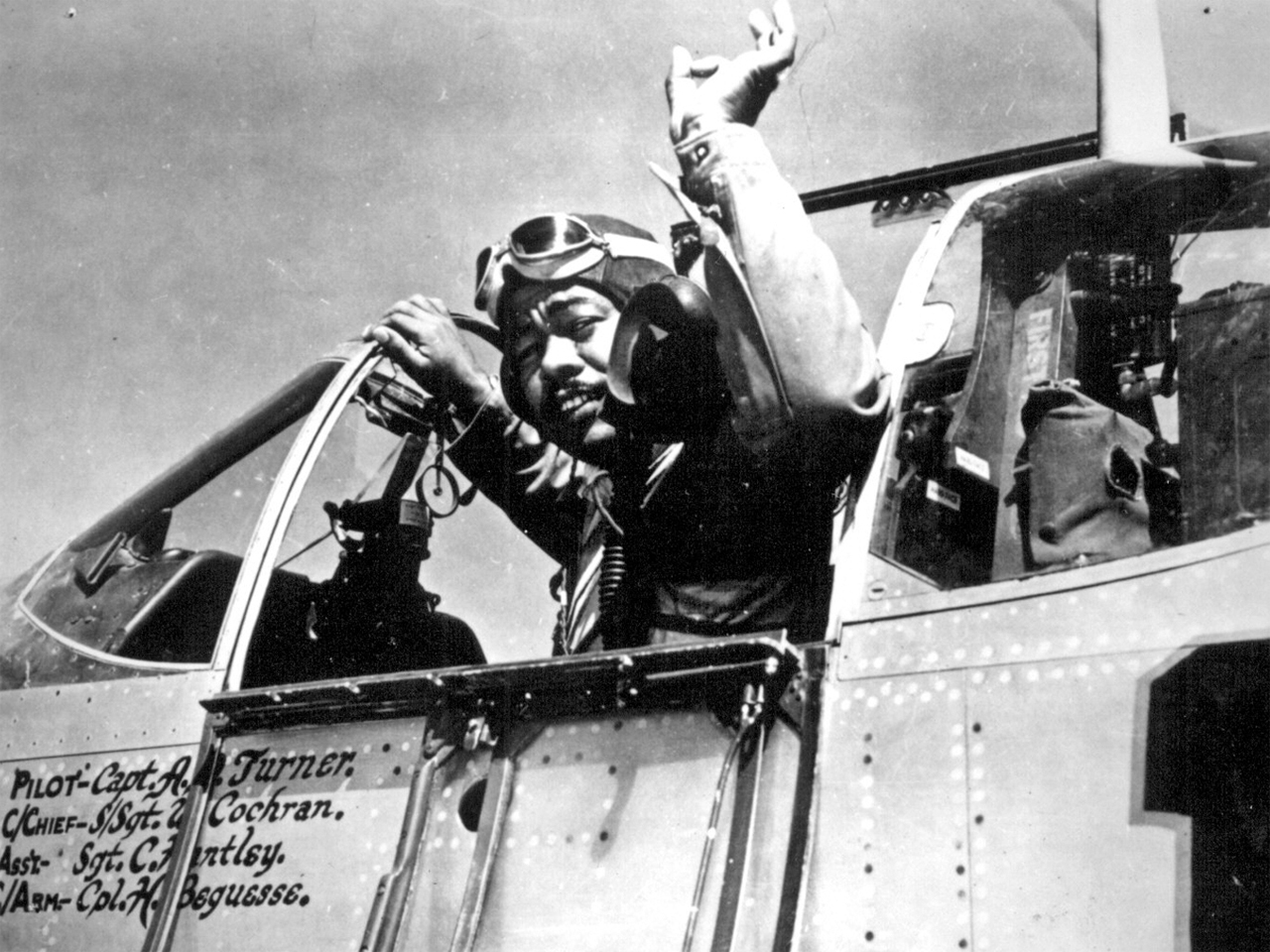Welcome to DU!
The truly grassroots left-of-center political community where regular people, not algorithms, drive the discussions and set the standards.
Join the community:
Create a free account
Support DU (and get rid of ads!):
Become a Star Member
Latest Breaking News
General Discussion
The DU Lounge
All Forums
Issue Forums
Culture Forums
Alliance Forums
Region Forums
Support Forums
Help & Search
General Discussion
Related: Editorials & Other Articles, Issue Forums, Alliance Forums, Region ForumsBlack History month: Day 8 - Taking on the Luftwaffe


Pilots of the 15th USAF in Italy


https://3.bp.blogspot.com/-L83EAimcP3E/TzNxi8xh55I/AAAAAAAADUA/n5na4TJBOYg/s1600/Tuskegee+Airmen.jpg
Tuskegee airmen
THE TUSKEGEE AIRMEN – FIGHTING FOR FREEDOM, IN THE AIR AND ON THE GROUND
http://zmblackhistorymonth2012.blogspot.com/2012/02/tuskegee-airmen-fighting-for-freedom-in.html
<snip>
The Tuskegee Airmen
First known as the 332nd Fighter Group and the 477th Bombardment Group of the U.S. Army Air Corps, The Tuskegee Airmen were the first African-American military aviators in the United States armed forces. During World War II, African-Americans in many U.S. States still were subject to the Jim Crow laws. The American military was racially segregated, as was much of the Federal Government. The Tuskegee Airmen were subject to racial discrimination, both within and outside the army. Despite these adversities, they trained and flew with distinction. Primarily made up of African-Americans, there were also five Tuskegee Airmen who were of Haitian descent. Although the 477th Bombardment Group "worked up" on North American B-25 Mitchell bombers, they never served in combat; the Tuskegee 332nd Fighter Group was the only operational unit, first sent overseas as part of Operation Torch, then in action in Italy, before being deployed as bomber escorts in Europe, where they were particularly successful in virtually all their missions.
Before the Tuskegee Airmen, no African-American had become a U.S. military pilot. In 1917, African-American men had tried to become aerial observers, but were rejected. However, Eugene Bullard, who was actually the first African-American fighter pilot, served as one of the members of the Franco-American Lafayette Escadrille. Nonetheless, he was denied the opportunity to transfer to American military units as a pilot when the other American pilots in the unit were offered the chance. Instead, Eugene returned to infantry duty with the French.
The racially-motivated rejections of World War I African-American recruits sparked over two decades of advocacy by African-Americans – led by civil rights leaders – who wished to enlist and train as military aviators. Finally, on April 3, 1939, Appropriations Bill Public Law 18 was passed by Congress containing an amendment designating funds for training African-American pilots. Tuskegee Airmen refers to all who were involved in the so-called Tuskegee Experiment, the Army Air Corps program to train African-Americans to fly and maintain combat aircraft. The Tuskegee Airmen included pilots, navigators, bombardiers, maintenance and support staff, instructors, and all the personnel who kept the planes in the air. The military selected Tuskegee Institute, in Tuskegee, Alabama, to train pilots because of its commitment to aeronautical training. Tuskegee had the facilities, and engineering and technical instructors, as well as a climate for year round flying. The first Civilian Pilot Training Program students completed their instruction in May 1940.
A further series of legislative moves by the United States Congress, in 1941, forced the Army Air Corps to form an all-black combat unit, despite the War Department's reluctance.
The Tuskegee Program began officially in June 1941 with the 99th Pursuit Squadron at the Tuskegee Institute. The unit consisted of 47 officers and 429 enlisted men, and was backed by an entire service arm. After basic training at Moton Field, they were moved to the nearby Tuskegee Army Air Field.
The budding flight program at Tuskegee received a publicity boost when First Lady Eleanor Roosevelt inspected it in March 1941, and subsequently flew with African-American Chief Civilian Instructor, C. Alfred "Chief" Anderson. Anderson, who had been flying since 1929, and was responsible for training thousands of rookie pilots, took his prestigious passenger on a half-hour flight in a Waco Biplane. After landing, she cheerfully announced, "Well, you can fly, all right!"
In May 1943, the 616th Bombardment Squadron was established as the initial subordinate squadron of the 477th Bombardment Group. The squadron was activated in July 1943, only to be deactivated six weeks later. By September of that year, the number of washed-out cadets on base had surged to 286, with few of them working. In January 1944, the 477th Bombardment Group was reactivated.
In all, 996 pilots were trained in Tuskegee from 1941 to 1946, approximately 445 were deployed overseas, and 150 Airmen lost their lives in accidents or combat.The casualty toll included 66 pilots killed in action or accidents, and 32 fallen into captivity, as prisoners of war.
The Tuskegee Airmen were credited by higher commands
with the following accomplishments:
15,533 combat sorties, 311 missions
112 German aircraft destroyed in the air, another 150 on the ground
950 railcars, trucks and other motor vehicles destroyed
One destroyer sunk
A good record of protecting U.S. bombers, losing only 25 on hundreds of missions.
After segregation in the military was ended in 1948, by President Harry S. Truman, with Executive Order 9981, the veteran Tuskegee Airmen found themselves in high demand throughout the newly-formed United States Air Force. Some taught in civilian flight schools, such as the black-owned
Columbia Air Center in Maryland.
On November 6, 1998, President Clinton approved Public Law 105-355, which established the Tuskegee Airmen National Historic Site at Moton Field in Tuskegee, Alabama, to commemorate and interpret the heroic actions of the Tuskegee Airmen during World War II. The new site contains a museum and interpretive programs at the historic complex at Moton Field, as well as a national center based on a public-private partnership.
Today, Tuskegee Airmen Inc. (TAI), which is a non-profit organization, with 55 chapters in the United States, works to introduce young Americans to the world of aviation and science, through local and national programs such as Young Eagles and TAI youth programs and activities. It also provides educational assistance to students and awards to deserving individuals, groups and corporations whose deeds lend support to TAI's goals. TAI also supports the Tuskegee Airmen Award presented to deserving cadets in the Air Force Junior Reserve Officer Training Corps Program.
Tuskegee, Alabama is small town, with a population of approx. 12,000. Yet, its fame is great. Some of its famous sons, daughters and institutions are: Rosa Parks, Lionel Ritchie and The Commodores, Booker T. Washington, George Washington Carver and the aforementioned, Tuskegee Institute – now Tuskegee University, which was founded by Booker T. Washington.
InfoView thread info, including edit history
TrashPut this thread in your Trash Can (My DU » Trash Can)
BookmarkAdd this thread to your Bookmarks (My DU » Bookmarks)
0 replies, 766 views
ShareGet links to this post and/or share on social media
AlertAlert this post for a rule violation
PowersThere are no powers you can use on this post
EditCannot edit other people's posts
ReplyReply to this post
EditCannot edit other people's posts
Rec (4)
ReplyReply to this post